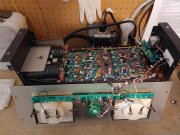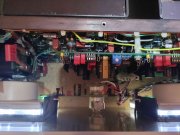mlucitt
Veteran and General Yakker
This is a picture of my bench "Mule" Full Complementary PL400 "WOPL" amplifier which I use to test newly assembled WOA Rev G1 Control Boards for customers. Yes, the wiring is long because I need to drop the Faceplate twice per test and sometimes I test two or three boards in one session. Also, note the large Series X 440VAC Line-to-Neutral Safety Capacitors I installed before Joe created his Bridge Rectifier Snubber Board.
In any case, a previous owner drilled a single hole in the otherwise nice Faceplate for a potentiometer. I deleted the Chinese potentiometer when I upgraded the amplifier to Full Complementary operation. The resulting hole bugged me, so I installed a double layer potentiometer because I like to have the input test signal low at Power On with an untested Control Board in place for the first time; my HP 3311A Function Generator is preset to 1.0V RMS and I don't like to turn it down and then recalibrate it every time I test a Control Board.
The 100K dual potentiometer was one I had in my parts drawer and it ended up being unequal from Channel A to Channel B, like the wafers were not "timed" or tracking correctly. This bugged me even more than a blank hole in the Faceplate.
So I searched for "Audiophile Quality" potentiometers (there are many from China). There are inexpensive resistor chain types, which just add more resistors in series to get the input signal down low and each resistor adds some noise. There are Ladder types, which only have two resistors in circuit at once. There are Shunt types, which only use two resistors but change the load impedance as you turn the control.
I finally selected the 24 position Goldpoint Level Control (stepped Ladder Type attenuator) in the 100K value. They can be had in one or more channels (up to 6) and I needed a two channel unit. The price is a bit steep, at $165.00. The P/N is V24-2-100K. Here: https://www.goldpt.com/prices.html
They also have a 47 position Level Control for $246.00, I thought that was a bit much too "Audiophile" for me. These Goldpoint Level Controls use 0.5%, 25ppm, Nichrome Thin Film, surface mount, precision resistors. The switch mechanism components come from Switzerland and the thick, hard gold contacts are "make-before-break" so there are no pops or clicks. Can you tell I really like these Goldpoint Level controls? The sound is actually improved, and the amplifier has more volume at the 12 o'clock position, although this might be a difference in the audio taper from the previous carbon potentiometers. From Goldpoint:
"Starting at full counter-clockwise rotation (OFF), the decibel step sizes are 9, 7, 6, 4, 3 and then 2dB for all 17 remaining steps up to full ON. This Goldpoint defined taper optimizes and is plenty of steps for volume control of most systems. The 15 degree switching, 24-position stepped attenuators provide 62dB of total attenuation."
I recommend these level controls for the ultimate WOPL upgrades. I like the Bourns potentiometers, but these sound better, have the tactile "click" and fit into our amplifiers. See second picture:

This is the WOPL Full Complementary Mule with the Faceplate bolted on and running with some Classis Rock playing in the background. The dual channel Goldpoint Level Attenuator fits inside the amplifier nicely.

In any case, a previous owner drilled a single hole in the otherwise nice Faceplate for a potentiometer. I deleted the Chinese potentiometer when I upgraded the amplifier to Full Complementary operation. The resulting hole bugged me, so I installed a double layer potentiometer because I like to have the input test signal low at Power On with an untested Control Board in place for the first time; my HP 3311A Function Generator is preset to 1.0V RMS and I don't like to turn it down and then recalibrate it every time I test a Control Board.
The 100K dual potentiometer was one I had in my parts drawer and it ended up being unequal from Channel A to Channel B, like the wafers were not "timed" or tracking correctly. This bugged me even more than a blank hole in the Faceplate.
So I searched for "Audiophile Quality" potentiometers (there are many from China). There are inexpensive resistor chain types, which just add more resistors in series to get the input signal down low and each resistor adds some noise. There are Ladder types, which only have two resistors in circuit at once. There are Shunt types, which only use two resistors but change the load impedance as you turn the control.
I finally selected the 24 position Goldpoint Level Control (stepped Ladder Type attenuator) in the 100K value. They can be had in one or more channels (up to 6) and I needed a two channel unit. The price is a bit steep, at $165.00. The P/N is V24-2-100K. Here: https://www.goldpt.com/prices.html
They also have a 47 position Level Control for $246.00, I thought that was a bit much too "Audiophile" for me. These Goldpoint Level Controls use 0.5%, 25ppm, Nichrome Thin Film, surface mount, precision resistors. The switch mechanism components come from Switzerland and the thick, hard gold contacts are "make-before-break" so there are no pops or clicks. Can you tell I really like these Goldpoint Level controls? The sound is actually improved, and the amplifier has more volume at the 12 o'clock position, although this might be a difference in the audio taper from the previous carbon potentiometers. From Goldpoint:
"Starting at full counter-clockwise rotation (OFF), the decibel step sizes are 9, 7, 6, 4, 3 and then 2dB for all 17 remaining steps up to full ON. This Goldpoint defined taper optimizes and is plenty of steps for volume control of most systems. The 15 degree switching, 24-position stepped attenuators provide 62dB of total attenuation."
I recommend these level controls for the ultimate WOPL upgrades. I like the Bourns potentiometers, but these sound better, have the tactile "click" and fit into our amplifiers. See second picture:

This is the WOPL Full Complementary Mule with the Faceplate bolted on and running with some Classis Rock playing in the background. The dual channel Goldpoint Level Attenuator fits inside the amplifier nicely.


